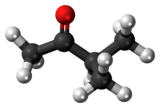Methyl isopropyl ketone
 | |
 | |
| Names | |
|---|---|
| IUPAC name
3-Methylbutan-2-one | |
| Other names
Isopropyl methyl ketone, MIPK, 2-Acetyl propane 3-Methyl-2-butanone | |
| Identifiers | |
| 563-80-4 | |
| 3D model (Jmol) | Interactive image |
| ChemSpider | 10777 |
| ECHA InfoCard | 100.008.423 |
| EC Number | 209-264-3 |
| PubChem | 11251 |
| |
| |
| Properties | |
| C5H10O | |
| Molar mass | 86.13 g/mol |
| Appearance | Colorless liquid |
| Odor | Acetone-like |
| Density | 0.803 g/cm³ (20 °C) |
| Melting point | −92 °C (−134 °F; 181 K) |
| Boiling point | 92 °C (198 °F; 365 K) |
| 6-8.2 g/l (20 °C) | |
| Vapor pressure | 8.6 kPa (20 °C) |
| Refractive index (nD) |
1.389 (20 °C) |
| Viscosity | 0.48 mPa·s (20 °C) |
| Hazards | |
| Flash point | 5 °C (41 °F) |
| 475 °C (887 °F; 748 K) | |
| US health exposure limits (NIOSH): | |
| PEL (Permissible) |
none[1] |
| REL (Recommended) |
TWA 200 ppm (705 mg/m3)[1] |
| IDLH (Immediate danger) |
N.D.[1] |
| Except where otherwise noted, data are given for materials in their standard state (at 25 °C [77 °F], 100 kPa). | |
| | |
| Infobox references | |
3-Methyl-2-butanone (methyl isopropyl ketone, MIPK) is a ketone and solvent of minor importance. It is comparable to MEK (Methyl ethyl ketone), but has a lower solvency and is more expensive.[2]
References
- 1 2 3 "NIOSH Pocket Guide to Chemical Hazards #0424". National Institute for Occupational Safety and Health (NIOSH).
- ↑ Dieter Stoye (2007), "Solvents", Ullmann's Encyclopedia of Industrial Chemistry (7th ed.), Wiley, pp. 55–56
This article is issued from Wikipedia - version of the 3/16/2016. The text is available under the Creative Commons Attribution/Share Alike but additional terms may apply for the media files.